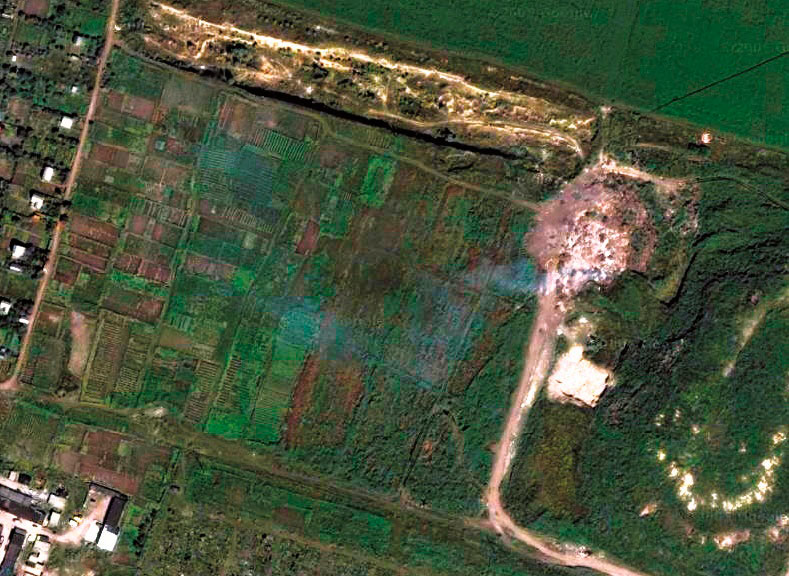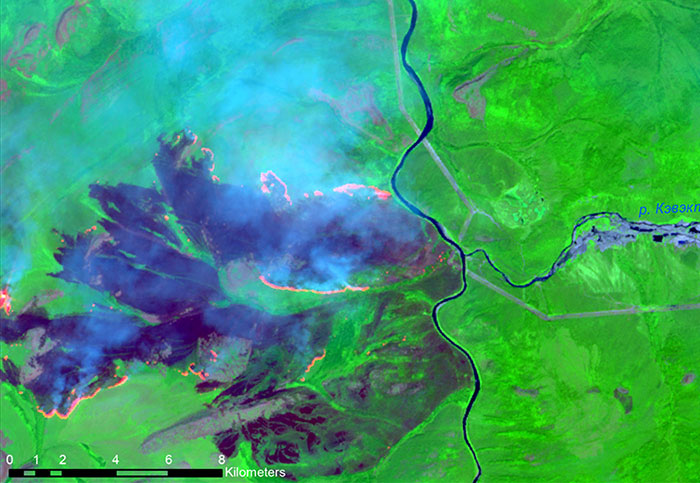Sat-Sun: Non-working days
According to the Methodological Recommendations for Conducting State Forest Inventory by Rosleskhoz dated November 10, 2011, No. 472, remote monitoring of forest use refers to the systematic tracking of the state of forest use to timely identify and predict the development of processes that negatively impact forests based on the interpretation of satellite imagery.
The state forest inventory is conducted using both ground and satellite methods with the use of statistical sampling methods. Aerospace methods are used for the timely identification and prediction of processes that negatively impact forests, primarily in areas of intensive forest use.
Ground methods are used to determine the quantitative and qualitative characteristics of forest plots, as well as to evaluate the effectiveness of measures for the protection, conservation, and reproduction of forests. The scale of work for the inventory of Russian forests is so vast that specialists believe a full inventory cycle will take 10-15 years.
Satellite monitoring is an integral part of forest management and inventory activities. It is especially important for the extensive forest areas of Russia.
Modern satellite imaging tools allow for the acquisition of operational and reliable information about the state of forests and economic activities in any remote area, which is practically unachievable through ground surveys. Additionally, they enable retrospective analysis of the area, aimed at recording the beginning and end of various events.
The study evaluates the feasibility of using Sentinel-2 satellite images from the European Space Agency for mapping (interpreting) forest plantations in one of the districts of the Perm Krai. The scheme of the analysis plots in the territory of the Perm Krai is shown in Figure 1.

To identify forest clearings, multi-temporal satellite imagery from Sentinel-2 was used. Multi-temporal images of the same area allow for a high probability of detecting changes that have occurred in the region.
Satellite imaging for forest monitoring tasks should be conducted in the spring, summer, or fall seasons, predominantly during the vegetative period. Winter imaging, when snow cover is present, can be used as an exception to complement snow-free period imaging to highlight the contrast of certain objects.
Using specialized software products ENVI, ScanEx Image Processor, and the ESRI geographic information system (ArcGIS), the area of interest was interpreted both visually and automatically.
The authors analyzed areas with suspected clearings using two methods of satellite data classification:
-
Visual – through expert comparison of multi-temporal images and using an automated change detection method.
- Automated – change detection includes a wide range of methods used to identify, describe, and quantify differences between images of the same scene at different times.
1. Visual Interpretation
Conducted by several employees with subsequent cross-checking to minimize systemic errors.
After preliminary procedures aimed at improving the images and masking cloud cover, analysis was conducted within the declared cadastral subdivisions.
Analysis Plot No. 1.
Clearings that appeared during the period between the two images are depicted in bright red: the low brightness in the March 2016 image is due to the presence of woody vegetation, which provides a strong return signal. The high brightness in the April 2016 image is associated with a weak return signal from a flat surface without woody vegetation (light phototone within the contour of plot 1), as shown in Figure 2.
Statistical analysis of the conducted study indicates that the clearing area that occurred from mid-March to mid-April 2016 was about 78%.
Analysis Plot No. 2
Using visual analysis of multi-temporal satellite images for Plot 2, changes that occurred between mid-March 2016 and mid-April 2016 were detected, as shown in Figure 3.
Statistical analysis of the conducted study indicates that the clearing area was about 60%.
Analysis Plot No. 3.
According to Sentinel-2 satellite imagery, no forest clearings were detected, as shown in Figure 4.
Analysis Plot No. 4
According to Sentinel-2 satellite imagery, no forest clearings were detected, as shown in Figure 5.
Analysis Plot No. 5.
According to Sentinel-2 satellite imagery, no forest clearings were detected, as shown in Figure 6.

2. Automated Decryption
The analysis of change detection involves a wide range of methods used to identify, describe, and quantitatively determine differences between images of the same scene at different times. We utilized tools such as Band Math and Principal Component Analysis (PCA), which were analyzed both independently and in combination. These procedures, within the ENVI software, offer a straightforward approach to detecting changes between a pair of images representing initial and final states.
When performing automated change detection analysis on satellite images, it is important to consider all factors that may cause scenes in the same area to appear differently. Some of these factors include:
-
Differences in instrumentation or sensors: Consider the similarity of sensors collecting the images. Even bands collected in the same part of the spectrum (e.g., two red bands) may have different wavelengths or spectral response functions, leading to different pixel values for the same material.
- Differences in date and time of collection. Seasonal changes can lead to significant differences in scenes containing vegetation (due to plant aging and canopy development). Differences in season and time of day also affect the azimuth and solar elevation.
- Differences in atmospheric conditions. Dominant weather conditions can affect atmospheric transmission and scattering. Persistent differences in rough atmospheric conditions are often associated with seasonal changes. A common atmospheric distinction is the water content in the atmosphere. Summer atmosphere is usually more humid than winter atmosphere. Atmospherically corrected images can mitigate such influences.
- Accuracy of registration. The detail of georeferenced images is crucial for change detection analysis. Although the change detection difference map procedure automatically aligns the input images using available map information, if differences in image geometry are significant, it is worth attempting to ensure as accurate a coregistration as possible before performing change detection.
Once the source images are loaded (initial and final state of the area), it is necessary to specify the number for classification in the "Compute Input Parameters for Difference Map" dialog. Each class is defined by a difference threshold, representing a different amount of change between the two images. The minimum number of classes is two. Classification thresholds by default are evenly distributed between (-1) and (+1) for simple differences and (-100%) and (+100%) for percentage differences. Default class definitions attempt to create symmetric classes with equal numbers of positive and negative change classes surrounding the "No Change" category. The order in which classes are defined is as follows:
For n classes, where n is odd, the first (n/2) classes represent positive changes, starting from the largest positive changes and ending with the smallest. The middle class, (n/2) + 1, represents no change. The last (n/2) classes represent negative changes, starting from the smallest negative changes and ending with the largest.
It was decided experimentally to classify into 33 classes. Thus, multi-temporal composites of analysis areas No. 1 and No. 2 were created.
Analysis Area No. 1.
Both methods of thematic analysis of satellite imagery (visual and automated) suggest that deforestation occurred between March and April 2016 and amounted to approximately 78%, as shown in Figure 7. The areas were analyzed in the near-infrared range (NIR).
Both methods of thematic analysis of the satellite image (visual and automated) suggest that logging occurred between March and April 2016 and amounted to approximately 62% as shown in Figure 8. Automated interpretation of Sentinel-2 imagery for the area of allotment #3, #4 and #5 was carried out using principal component analysis (PCA analysis). The results are shown in Figures 9, 10, and 11, respectively. This is used to create uncorrelated output frequency bands to separate noise components and reduce the dimensionality of the datasets. Since multispectral data bands are often highly correlated, the PCA transform is used to produce uncorrelated output bands. This is done by finding a new set of orthogonal axes that originate from the mean of the data and rotated so that the variance of the data is maximized.
Figure 9. Principal Component Analysis based on Sentinel-2 imagery. Area No.3 - blue outline

Figure 10. Principal Component Analysis based on Sentinel-2 imagery. Area No.4 - blue outline

Following comprehensive processing of Sentinel-2 satellite images, it was determined that almost continuous deforestation occurred in areas with cadastral numbers 1 and 2 (Table 1). Deforestation presumably occurred between mid-March 2016 and mid-April 2016.
No forest cover disturbances or clearcutting were detected in areas with cadastral numbers 3, 4, and 5 based on Sentinel-2 satellite imagery.
CONCLUSION
1. Based on comprehensive processing of Sentinel-2 satellite images using both visual and automated methods, it was established that almost continuous deforestation occurred in areas with cadastral numbers 1 and 2 (Table 1). Deforestation presumably occurred between mid-March 2016 and mid-April 2016. No forest cover disturbances or clearcutting were detected in areas with cadastral numbers 3, 4, and 5.
2. Table 1 presents a comparison of deforestation area at the end and beginning of observations.
Table 1. Comparison of deforestation area at the end and beginning of observations
|
Analysis Area |
Area of Analysis Area in hectares |
Deforestation Area in hectares in March 2016 |
Deforestation Percentage in April 2016, % |
Deforestation Percentage in February 2017, % |
|
1 |
7.21 |
5.63 |
78% |
78% |
|
2 |
1.43 |
0.52 |
36% |
62% |
|
3 |
35.39 |
0 |
0% |
0% |
|
4 |
11.92 |
0 |
0% |
0% |
|
5 |
2.35 |
0 |
0% |
0% |
3. The work conducted can serve as a prominent example of applying innovative space methods, in conjunction with advanced technologies (including machine learning), for detecting violations of forest cover integrity. Moreover, it can assist in accurately delineating the timeframes of documented changes.
4. Satellite imagery represents a progressive method and an integral stage for monitoring forest lands.










